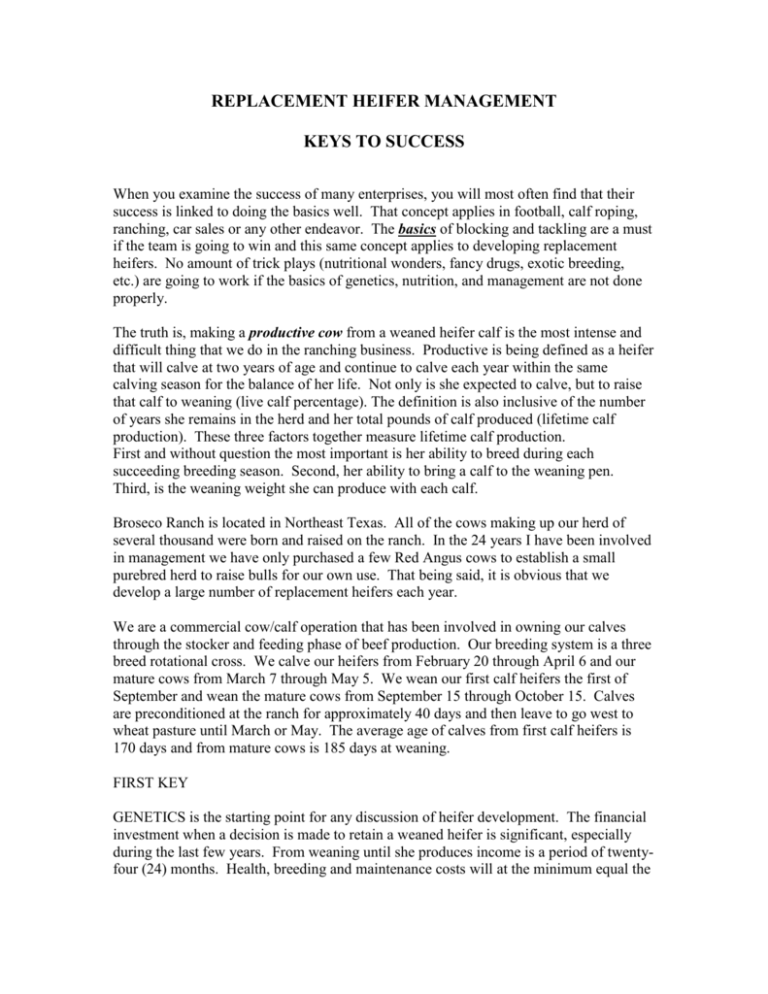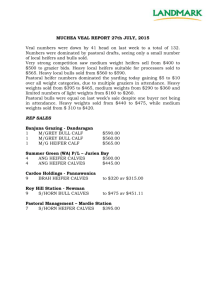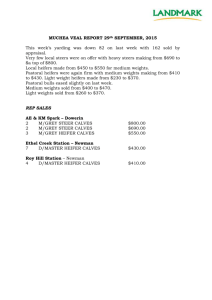Tom Woodward
advertisement

REPLACEMENT HEIFER MANAGEMENT KEYS TO SUCCESS When you examine the success of many enterprises, you will most often find that their success is linked to doing the basics well. That concept applies in football, calf roping, ranching, car sales or any other endeavor. The basics of blocking and tackling are a must if the team is going to win and this same concept applies to developing replacement heifers. No amount of trick plays (nutritional wonders, fancy drugs, exotic breeding, etc.) are going to work if the basics of genetics, nutrition, and management are not done properly. The truth is, making a productive cow from a weaned heifer calf is the most intense and difficult thing that we do in the ranching business. Productive is being defined as a heifer that will calve at two years of age and continue to calve each year within the same calving season for the balance of her life. Not only is she expected to calve, but to raise that calf to weaning (live calf percentage). The definition is also inclusive of the number of years she remains in the herd and her total pounds of calf produced (lifetime calf production). These three factors together measure lifetime calf production. First and without question the most important is her ability to breed during each succeeding breeding season. Second, her ability to bring a calf to the weaning pen. Third, is the weaning weight she can produce with each calf. Broseco Ranch is located in Northeast Texas. All of the cows making up our herd of several thousand were born and raised on the ranch. In the 24 years I have been involved in management we have only purchased a few Red Angus cows to establish a small purebred herd to raise bulls for our own use. That being said, it is obvious that we develop a large number of replacement heifers each year. We are a commercial cow/calf operation that has been involved in owning our calves through the stocker and feeding phase of beef production. Our breeding system is a three breed rotational cross. We calve our heifers from February 20 through April 6 and our mature cows from March 7 through May 5. We wean our first calf heifers the first of September and wean the mature cows from September 15 through October 15. Calves are preconditioned at the ranch for approximately 40 days and then leave to go west to wheat pasture until March or May. The average age of calves from first calf heifers is 170 days and from mature cows is 185 days at weaning. FIRST KEY GENETICS is the starting point for any discussion of heifer development. The financial investment when a decision is made to retain a weaned heifer is significant, especially during the last few years. From weaning until she produces income is a period of twentyfour (24) months. Health, breeding and maintenance costs will at the minimum equal the initial value of the heifer during that time. Therefore one would like to know that the investment will be worth the effort. The genetic ability of the heifer to do all things necessary to be that productive cow is multifaceted. Will she be environmentally adapted? Will her milk production be balanced with her environment? Will she be a good forager? Will she have good mothering ability? Will she have parasite or heat tolerance? Will she have the correct mature size for her environment? Will she reach puberty in time to breed and calve at two years of age? . Will she calve easily as a first calf heifer? Will she mother the calf and bring it to the weaning pen? I am sure there are even more questions that could be asked but the above list is plenty to start with. Whether one is retaining their own replacements or purchasing replacements, all of the above questions need to be considered. I will grant you that the heritability of fertility is low but I will also grant you that if a cow has been productive and has had the ability to reproduce under my environment then her heifers has some built in genetic adaptability. Mama probably had to have some heat tolerance. She was probably about the right size, had the right amount of milk, was a good forager, and had good mothering ability or she would not have stayed in the herd. Obviously she didn’t die having her first calf. As I raise or purchase bulls, by necessity I must pay attention to more than just growth or carcass traits if I am going to maintain the productivity of the herd. The best tools we have are EPD’s. Most breeds now have good databases and a variety of EPD’s that measure the growth, maternal and carcass traits. The challenge is to select those bulls that can balance the traits because without question, the practice of single trait selection will eventually lead to a wreck. How many people during the late 60’s the 70’s bought the largest framed bulls they could find? They were looking for fast growing calves that would wean heavy. Nothing wrong with that is there? But guess what, the heifer mates were lousy mothers. You might have gotten them to breed the first time if you fed them enough but that might have been the last time they bred. They got huge and the maintenance requirements to facilitate reproduction were usually unmet under range conditions. My sons showed heifers during their high school days and I still remember having some that did well in the shows. Of course they were big good heifers. A close friend had kids showing during the same time frame and he once told me that he paid a bunch of money for an old heifer that won her class at ever major show in the state and even championed out a few time. She was a monster. He said he then took her home, took her out behind the barn and shot her so she wouldn’t multiply. Well, maybe that’s a little extreme but you get the point. The poorest producing cows in my herd were usually those big framed heifers that were selected because they had a phenotype that worked well in shows. Is the seedstock breeder you are buying bulls from using 1600-1700 weight cows to produce his bulls? Will they work in your environment? We don’t have to make those mistakes anymore. Using the Red Angus breed for a moment let’s look at the EPD’s that are there to help us select the bulls that will sire heifers that will work. Since I have been talking about size, there is an EPD that calculates the difference in Mcal/month of metabolizable energy for maintenance. If used in a profit function, it estimates differences in cow herd feed costs and /or reproductive failure due to inadequate nutrition. There is a heifer pregnancy EPD, in percent probability, of heifers breeding to calve at two years of age. Another great EPD is stayability. This is expressed in the percent probability that a bull’s daughter will remain in the herd until at least six years of age. There is also a calving ease direct and a calving ease total maternal EPD. So here are five EPD’s that can be used that will help identify those bulls that should leave good females in your herd. Most progressive breed associations will have similar EPD’s that you can use in building your genetic base. I have tried to make the case here that the cow that’s productive mated with a bull selected for some maternal traits should provide the best opportunity to produce heifers that will work in a given environment. I can’t go further without dealing with the point many economists would make, “you can buy them cheaper than you can raise them”. I can’t argue with that simple economic equation but I will have to ask, “what genetics do you have when you buy her”? Do you have any idea about the genetic ability of the bulls they were sired by? For the operation with the ability to produce several hundred calves annually, don’t forget about the significance of genetics. SECOND KEY NUTRITION, most often, is the reason for failure to get heifers bred to calve at two. Research has shown that if a heifer is going to have a chance to cycle and breed at fourteen to fifteen months of age, she must be weighing about 65% of her mature weight. So if she is going to weigh 1200 at maturity, she must be weighing around 780 pounds when she is to be bred. Many research papers have been published on this and my goal here is not to quote that information but to deal with the basic logistics of getting her there. The math is pretty simple. From weaning at 210 days of age till breeding time at 440 days of age, we have 230 days to work with. If she weans at 500 pounds then we need to get her to gaining at a rate of 1.22 pounds per day to reach our target of 780 pounds. But as usual averages can be deceiving. What about the heifer that weighed less than 500 at weaning? If she weighed 450 then she is going to need to gain at 1.44 pounds per day to reach her target. The old rule of thumb then is still pretty close. Heifers need to be on a nutritional program to gain approximately 1.50 pounds per day. From the simple example above, it is evident that preweaning gain is also very significant. Heifers born during the last 30 days of the calving season are at a disadvantage. Not only are they possibly lighter at weaning but they are also 30 days younger. Yes some will get there but the odds are against them. The environment will determine to some extent how heifers are developed. The feedlot is the most exact way to get there. Winter pasture works well and at the bottom of the list is probably hay and supplement. Under feedlot conditions, the rate of gain is usually pushed well above the 1.5 pounds per day and for those with access to a feedlot that will develop heifers, the process is a good one. If artificial insemination is going to be used, it makes it even easier since they are already in confinement. The caution I would offer here is that the ration should be low in corn and high in complex carbohydrates and roughage. The heifer’s rumen is going to be much better adapted to using pasture forages when she comes out of the feedlot and will not suffer as much weight loss or the lack of gain during the transition period. I routinely develop heifers on winter pasture. Since growing condition is a limiting factor, it requires a readiness to supplement the pasture if grazing is short. The actual out of pocket cost of gain on winter pasture will usually be less than $.30 per pound. If the heifers are gaining 1.5 pounds per day, then the cost is about $.45 per day and if they are on pasture for 150 days the total cost is $68 per head. Supplement and mineral costs would be in addition to this. A complete, high quality mineral is an important consideration in heifer development. The process begins with her mother so that the heifer has developed a good immune system prior to weaning. The heifer will come through the post weaning stress with less chance of breaking with a respiratory disease if her immune system is strong going into weaning. Once on winter pasture, I supply the same quality of mineral and measure consumption to be sure they are consuming the proper amount. Putting a good mineral in the pasture doesn’t accomplish much if they are not consuming it. Over feeding heifers and getting them fat isn’t the solution because it can have consequences at calving and on production throughout the rest of her life. THIRD KEY MANAGEMENT of the heifer selection process, the breeding season, and calving are three other major areas to consider. What selection criteria should be used in the replacement selection process, how long should the breeding season be and how do we manage the calving season? There are many varied approaches to these, so I am just going to relate how I approach them in our operation. We artificially inseminate 600-700 head of heifers each year and that occurs approximately two weeks in front of the breeding season for mature cows. There are another 400-500 heifers that bulls are put with at the same time. Our total breeding season on heifers is 45 days with a goal of getting 90% bred. I mention this first because it is my goal to use many of the AI sired heifers as replacements. We tag and weigh all the calves from first calf heifers at birth. We also catch an individual weaning weight on all calves from first calf heifers and that is used in the selection process. We do not tag calves from mature cows at birth but we do catch individual weights at weaning and that is used as the first sort. The heifers are then sorted on phenotype. I will retain 10-15% more heifers than I plan to breed and then make another sort on the heifers prior to breeding season. The bulls used for both natural service and AI are selected for light birth weight and calving ease. All of the natural service bulls are Red Angus and the AI sires are both Red Angus and Angus. We bring our bred heifers into traps during the calving season and check them four times a day. They are ridden first thing early in the morning, late morning, mid afternoon and early evening. On occasion we will make a check during the night. The calving crews are well equipped and have access to pens and chutes. Weather is our greatest enemy. The cold wet conditions present a challenge and cost us some calves. Our goal is a 90% live calf crop from heifers tested pregnant. We do not have the human resources to baby set each animal so our results are probably not as good as one might expect from a more intense or purebred operation. .




